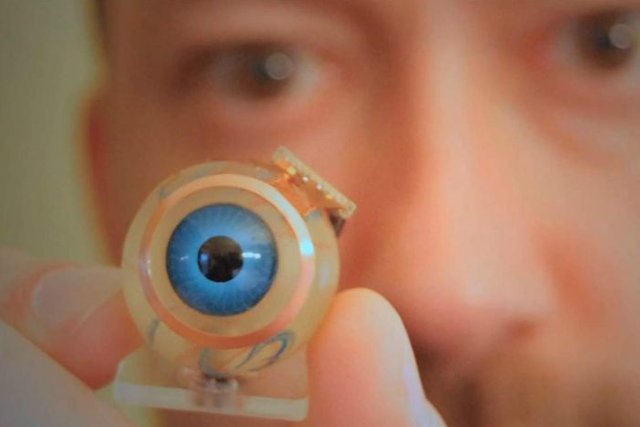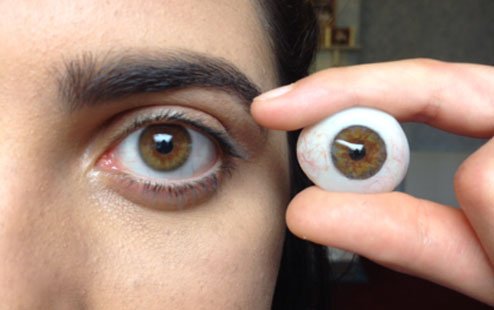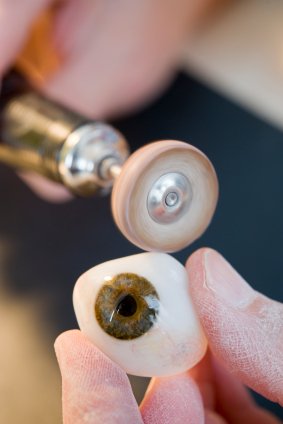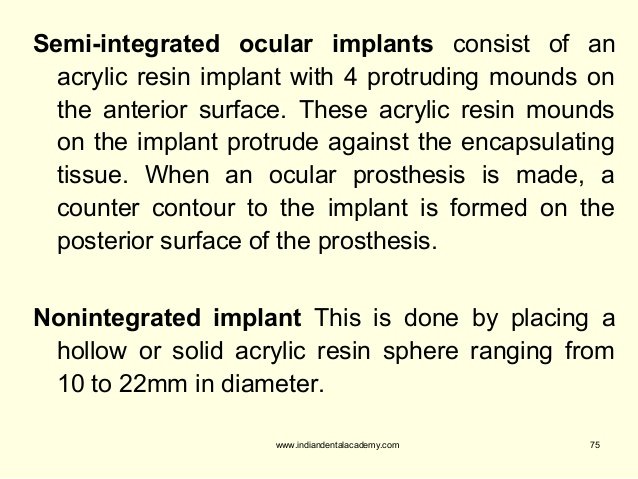
The Artificial Eye. A Human leap in Technology. How It's made.

What Is It?
An ocular prosthesis, artificial eye or glass eye is a type of craniofacial prosthesis that replaces an absent natural eye following an enucleation, evisceration, or orbital exenteration. The prosthesis fits over an orbital implant and under the eyelids. Though often referred to as a glass eye, the ocular prosthesis roughly takes the shape of a convex shell and is made of medical grade plastic acrylic. A few ocular prostheses today are made of cryolite glass. A variant of the ocular prosthesis is a very thin hard shell known as a scleral shell which can be worn over a damaged or eviscerated eye. Makers of ocular prosthetics are known as ocularists. An ocular prosthesis does not provide vision; this would be a visual prosthesis. Someone with an ocular prosthesis is totally blind on the affected side and has monocular (one sided) vision.

How It's Made...
There are many different types of implants, classification ranging from shape (Spherical vs egg (oval) shaped), stock vs custom, porous vs nonporous, specific chemical make-up, and the presence of a peg or motility post. The most basic simplification can be to divide implant types into two main groups: non-integrated (non-porous) and integrated (porous).

Nonintegrated implants
Though there is evidence that ocular implants have been around for thousands of years modern nonintegrated spherical intraconal implants came into existence around 1976 (not just glass eyes). Nonintegrated implants contain no unique apparatus for attachments to the extraocular muscles and do not allow in-growth of organic tissue into their inorganic substance. Such implants have no direct attachment to the ocular prosthesis. Usually, these implants are covered with a material that permits fixation of the extraocular recti muscles, such as donor sclera or polyester gauze which improves implant motility, but does not allow for direct mechanical coupling between the implant and the artificial eye. Non-integrated implants include the acrylic (PMMA), glass, and silicone spheres.

Eyes Prosthetics, Polymethyl methacrylate
Polymethyl methacrylate (PMMA) is a transparent thermoplastic available for use as ocular prosthesis, replacement intraocular lenses when the original lens has been removed in the treatment of cataracts and has historically been used as hard contact lenses. PMMA has a good degree of compatibility with human tissue, much more so than glass. Although various materials have been used to make nonintegrated implants in the past, polymethyl methacrylate is one of the implants of choice.
Integrated implants (porous)
The porous nature of integrated implants allows fibrovascular ingrowth throughout the implant and thus also insertion of pegs or posts. Because direct mechanical coupling is thought to improve artificial eye motility, attempts have been made to develop so-called ‘integrated implants’ that are directly connected to the artificial eye. Historically, implants that directly attached to the prosthesis were unsuccessful because of chronic inflammation or infection arising from the exposed nonporous implant material. This led to the development of quasi-integrated implants with a specially designed anterior surface that allegedly better transferred implant motility to the artificial eye through the closed conjunctiva and Tenon’s capsule. In 1985, the problems associated with integrated implants were thought to be largely solved with the introduction of spherical implants made of porous calcium hydroxyapatite. This material allows for fibrovascular ingrowth within several months. Porous enucleation implants currently are fabricated from a variety of materials including natural and synthetic hydroxyapatite, aluminium oxide, and polyethylene.
a video on how artificial eyes are made
If you liked the content, be sure to Follow, Upvote and Resteem! I will always Follow and Resteem back!

Wow!
Downvoting a post can decrease pending rewards and make it less visible. Common reasons:
Submit
Incredible isn't it? Blows my mind!
Downvoting a post can decrease pending rewards and make it less visible. Common reasons:
Submit
Im wondering how it sends visuals to your or is it just for show.
Downvoting a post can decrease pending rewards and make it less visible. Common reasons:
Submit
A post I think my favorite Curators would enjoy! Be sure to drop them a follow! They're the
lifeblood of quality content on this platform!
@hendrikdegrote @curie @vcelier @kushed @anwenbaumeister @donkeypong @abit @kpine @sean-king
@ats-david @trafalgar @sweetsssj @geoffrey @livingfree @toxic @xeldal @thejohalfiles
@sponge-bob @ramblin-bob @starkerz @teamsteem
Downvoting a post can decrease pending rewards and make it less visible. Common reasons:
Submit
Hi! I am a robot. I just upvoted you! I found similar content that readers might be interested in:
http://www.mashpedia.com/Ocular_prosthesis
Downvoting a post can decrease pending rewards and make it less visible. Common reasons:
Submit